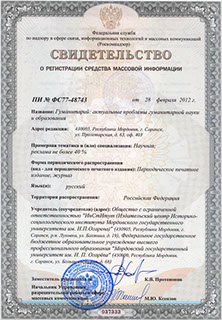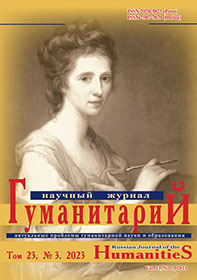ГуманитариЙ актуальные проблемы гуманитарной науки и образования
Russian Journal of the Humanities
ISSN 2078-9823 (Print)
ISSN 2587-7879 (Online)
Navigation
ISSN 2078-9823 (Print), ISSN 2587-7879 (Online)
DOI: 10.15507/2078-9823.063.023.202303.268-286
Olga V. Galtseva
Nizhny Novgorod State Historical and Architectural Museum-Reserve
(Nizhny Novgorod, Russia),
e-mail: оl.galczewa@yandex.ru
Russian Traditional Dance as a Language of Intraethnic Communication
Abstract
Introduction. The article aims to determine the nature of the participation of folk dance in the process of forming the ethnic and national identity of the Russian people. For this purpose, the dance is considered as a means of social communication and analyzed by the example of the most common variants of its application in the practice of everyday and festive communication of the Russian rural population of the Nizhny Novgorod region of the second half of the 20th century.
Materials and Methods. In the process of working on the article, a comparative historical method was used, which allowed us to present the dynamics of the historical development of traditional dance from the end of the 19th to the second half of the 20th centuries. The structural and functional method was also used which made it possible to determine the main functions of dance culture in the life of the rural community. These methods were used in combination with the analysis of historiographical works and sources, as well as methods of field research.
Results. Russian folk dance has undergone a number of changes over a certain historical period. Initially, it had a ritual and cult significance, developed within the framework of the male military tradition, and was used in the rituals of the calendar and wedding cycles. In the 20th century, the communicative potential of dance began to be directed to the rural community. Dance becomes the universal language of festive communication. It acquires the significance of one of the components of national identity after the Victory in the Great Patriotic War.
Discussion and Conclusion. The ethno-cultural significance of dance in the life of a rural community in the second half of the 20th century can be illustrated by the culmination of the annual village festival. During it, the dance of men, successors of their kind, heirs of the winners and defenders of the Fatherland, brings a final, life-affirming and archaic meaning to the general emotional unity. It proclaims the right of all participants in the holiday to live in their own land and honor their ancestors.
Keywords: dance, folk choreography, dance vocabulary, dance communication, traditional holiday communication, national identity.
For citation: Galtseva O. V. Russian Traditional Dance as a Language of Intraethnic Communication. Gumanitarian: aktual’nye problemy gumanitarnoi nauki i obrazovaniia = Russian Journal of the Humanities. 2023; 23(3): 268–286. (In Russ.). DOI: 10.15507/2078-9823.063.023.202303.268-286.

© Ogarev Mordovia State University. History and Sociology Institute, 2017
68, Of. 411, Bolshevistskaya St., 430005, The editorial office of the scholarly journal «Russian Journal of the Humanities»
Tel.: (8342) 24-25-90; 27-07-11, Fax: (8342) 24-25-90, E-mail: jurnal-econom-hist@isi.mrsu.ru
Designed by A. Napalkov, Email: napalkov@isi.mrsu.ru

